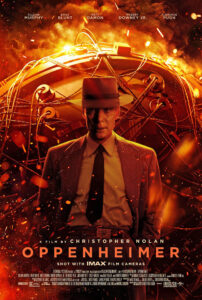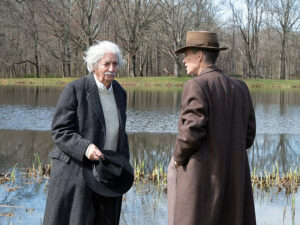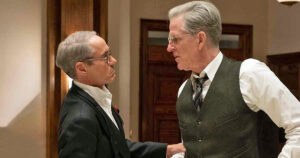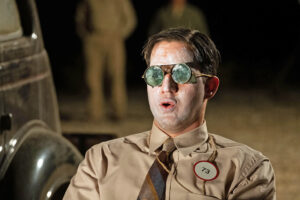 By Steve Crum
By Steve Crum
Oppenheimer is not a joy to behold. But it is a fascinating motion picture everyone should see…and absorb. It is also likely to be heralded at the Oscars as Best Picture.
As a Boomer, the film personally connects. Being a high school varsity debater in 1965, I verbally sparred about the threat of nuclear war with Russia. “Peaceful Coexistence” was an oft used term—coming from teens who had “ducked and covered” in classroom drills during the 1950s. It was all about the threat of the atomic bomb, which by the mid ‘60s had escalated to the hydrogen bomb. Twenty years earlier, in 1945, WWII ended with our atom bombs devastating Japan.
J. Robert Oppenheimer, the renowned theoretical physicist and “Father of the Atomic Bomb,” is a name never uttered during high school debates. But “The Bomb” certainly was.
Oppenheimer clarifies and defines his era.
The film’s narrative, written and directed by Christopher Nolan, encompasses an effective blend of historical documentary with dramatic thriller and biography. The immense and complex  telling takes 181 minutes and a raft of excellent actors—Cillian Murphy, Robert Downy Jr., Emily Blunt, Matt Damon, Rami Malek, Kenneth Branagh, and Florence Pugh among them.
telling takes 181 minutes and a raft of excellent actors—Cillian Murphy, Robert Downy Jr., Emily Blunt, Matt Damon, Rami Malek, Kenneth Branagh, and Florence Pugh among them.
The story structure begins during Oppenheimer’s 1926 university year and stays its course through nuclear discoveries in the late 1930s to WWII developments (both military and scientific) and then to postwar years with Presidents Truman through Johnson.
 Oppenheimer’s (Murphy) love life is included, focusing on dating Jean Tatlock (Pugh), a Communist Party member. This was the beginning of the upending of Oppenheimer’s controversial political leanings. Not only does he have friends who are Communist Party members, but ends up marrying Katherine “Kitty” (played by Blunt), an ex-member. It is no surprise that the brilliant scientist becomes the focus of House Un-American Activities accusations. His personal life becomes fodder for political retribution, despite the fact his Quantum Physics expertise led to the development and eventual dropping of the atom bomb on Japan that ended WWII.
Oppenheimer’s (Murphy) love life is included, focusing on dating Jean Tatlock (Pugh), a Communist Party member. This was the beginning of the upending of Oppenheimer’s controversial political leanings. Not only does he have friends who are Communist Party members, but ends up marrying Katherine “Kitty” (played by Blunt), an ex-member. It is no surprise that the brilliant scientist becomes the focus of House Un-American Activities accusations. His personal life becomes fodder for political retribution, despite the fact his Quantum Physics expertise led to the development and eventual dropping of the atom bomb on Japan that ended WWII.
A major player in the movie is Robert Downey Jr., who does a fine job as Oppenheimer’s nemesis, Lewis Strauss. The Atomic Energy  Commission’s Chairman, Strauss, held a long time resentment of Oppenheimer, and used his testimony to strip Oppenheimer of security clearance. Thus, Oppenheimer was blocked from anything to do with nuclear research. This sequence occurs in the third hour of the film. Before that happens, we witness Oppenheimer in full power as he heads a team in Los Alamos, New Mexico to develop a nuclear bomb to end the war.
Commission’s Chairman, Strauss, held a long time resentment of Oppenheimer, and used his testimony to strip Oppenheimer of security clearance. Thus, Oppenheimer was blocked from anything to do with nuclear research. This sequence occurs in the third hour of the film. Before that happens, we witness Oppenheimer in full power as he heads a team in Los Alamos, New Mexico to develop a nuclear bomb to end the war.
It is fascinating to witness the re-creation of that town built to house the scientists and technicians (and their families) while work proceeds. It all had to do with privacy and expediency. And it worked.
Interestingly, the film’s structure is laced with flashback sequences necessary for context references. Also, much of the story is narrated by Strauss/Downey Jr. To minimize any confusion regarding the story’s point-of-view, director Nolan chose to film Oppenheimer’s sequences in color. Strauss’s stances are shown in black and white. The result is subtle and clarifying. It truly helps in a movie as complex as Oppenheimer certainly is.
 Oppenheimer is packed with outstanding performances, particularly by the mostly unknown Cillian Murphy. He not only greatly resembles the brooding main character, but is totally believable.
Oppenheimer is packed with outstanding performances, particularly by the mostly unknown Cillian Murphy. He not only greatly resembles the brooding main character, but is totally believable.
There were things about the famous during those years I found fascinating. Take Albert Einstein, as portrayed by Tom Conti. And I am still jarred by the persona of President Harry Truman (Gary Oldman). I will not detail the latter here, but I had to research it after seeing the film to verify he did indeed say such to and about Dr. Oppenheimer.
In that regard, Oppenheimer is enjoyable, shocking and educational. It is part of our American history. Nolan himself describes his work as “beautiful and terrifying.”
I could not agree more.
—————
GRADE on an A-F Scale: A
